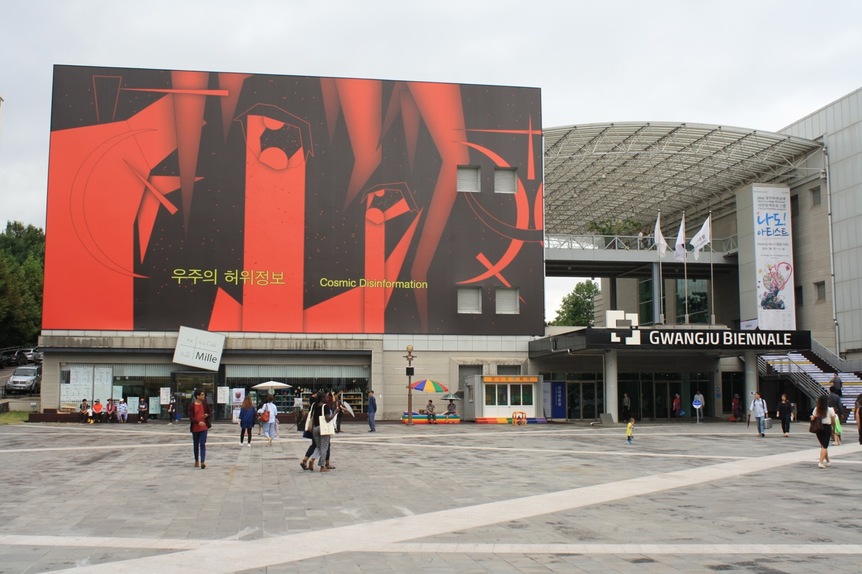The exterior of the Gwangju Biennale Hall is adorned with METAHAVEN ’s massive banner showing a “crying mother” character from manga, and a protagonist in their online film, commissioned by GB11, Information Skies. All photos by HG Masters for ArtAsiaPacific.
A view of Gallery 1 at the entrance, through the metallic curtains of RUTH BUCHANAN, with the photo-collage-banner Glass of Petrol (2016) by AGNIESZKA POLSKA.
In Gallery 1, INGELA IHRMAN’s sculptural recreation of the ubiquitous but invasive hogweed (Heracleum mantegazzianum), which also has a toxic sap, signaled some of the ecological concerns of artists in the Biennale, as the realities of climate change and environmental destruction are brought to bear on societies.
DORA GARCÍA made a 1:1 scale reproduction of the Nokdu Bookstore, which played a crucial role in the May 18, 1980, Democratic Uprising in Gwangju. Within the Biennale it’s a functioning store, selling historical books and art publications and also household items. The abstracted landscape of A View Beyond Space No. 4 (2015) by NABUQI is in front of it.
The interior of DORA GARCIA’s Nokdu Bookstore for the Living and the Dead (2016).
Another artist with an interest in natural and human systems is NICHOLAS MANGAN who presented his project “The Limits to Growth” (2016), based on the Rai currency used on the Micronesian island of Yap and its correlations to the crypto-currency Bitcoin.
ALMA HEIKKILÄ’s paintings and sculptures reflected patterns of organic growth, while BERND KRAUß’s sculptures behind it are derived from his experience of spending two months living in the galleries of Gwangju’s Mudeung Museum of Contemporary Art.
AMALIA PICA’s drawings The Joy in Paperwork (2015–16) number more than 1,000 and are made entirely from bureaucratic stamps.
Upstairs in Gallery 2, the open-plan layout is completely dark. Lind says it was inspired by the way Russian Constructivists had imagined an ideal exhibition viewing experience, where different works could be seen simultaneously. Here, the film Gomero (2015) by OSÍAS YANOV depicts cross-dressing characters posing in the branches of an enormous tree.
In Gallery 3, MICHAEL BEUTLER was making “paper sausages” from old paper and plastic netting, while AIMÉE ZITO LEMA’s enlarged copies of workers’ protests were draped over the contemporary version worksite (i.e., a desk). Fluorescent “clouds” by LI JINGHU illuminated the space.
ARSENY ZHILYAEV’s spectacular installation takes its forms from the Soviet-era space age, with tapestries that seem to commemorate futuristic events.
BABI BADALOV’s installation in the ramps between Gallery 3 and 4 revels in visual puns and word play.
In Gallery 4, there is a strong emphasis on abstraction. SUKI SEOKYEONG KANG’s installation Black Mat Oriole is based on the spatial arrangements of Chunaengmu, a form of Korean court dance from the 19th century.
MIKA TAJIMA’s hanging sculpture draws its form from a chair pulsing with energy that corresponds to the “emotional information” being broadcast online. The wall-weavings correspond to spectrogram images from field recordings at factories and data centers.
ADE DARMAWAN’s Somnambulism Inc. (2015) comprise hanging silk banners showing book covers by a defunct Indonesian publishing house called Magic Centre. The abstractions on their covers, created in and referencing the aftermath of Suharto’s “New Order” regime, were meant as interpretations of the country’s capitalistic reforms during the late 1960s.




